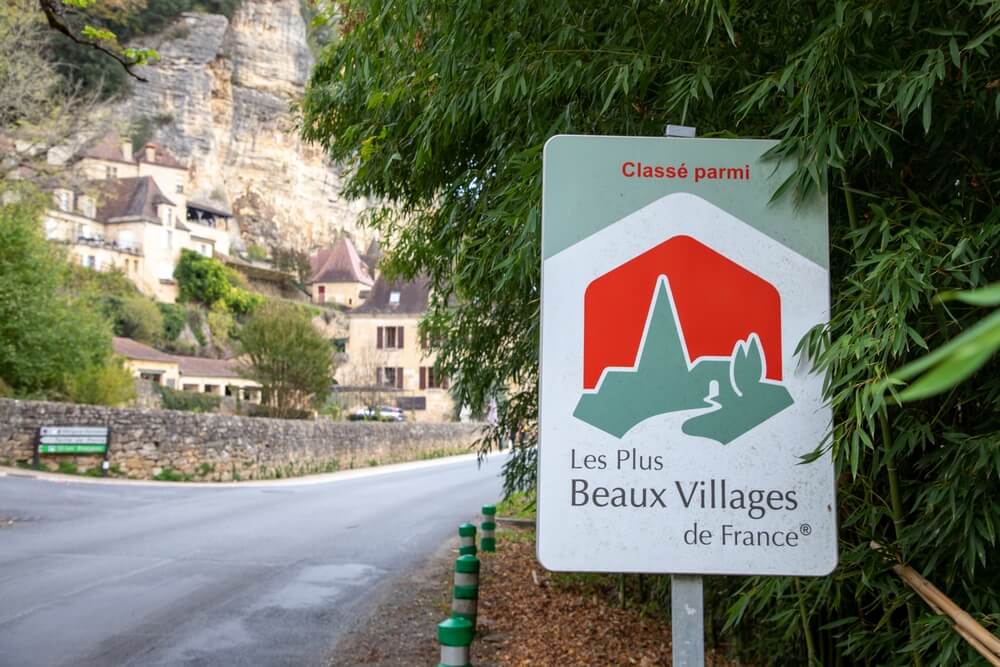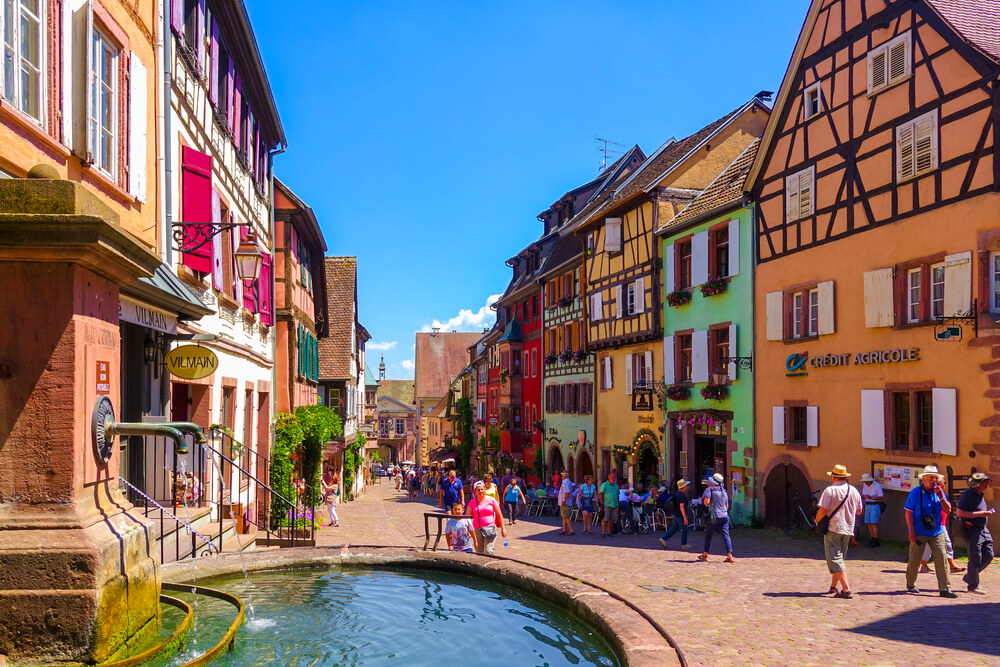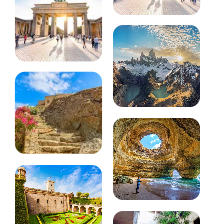The Most Beautiful Villages in France: 15 listed villages to visit

France has a wealth of architectural and heritage treasures scattered across its countryside. Among these jewels, 182 villages have been awarded the precious label “Les Plus Beaux Villages de France”, a distinction awarded according to strict criteria of heritage, architectural and environmental quality. These exceptional villages, which bear witness to our history and the diversity of our terroirs, are well worth a visit for their well-preserved authenticity and striking beauty.
Discover our selection of the 15 most beautiful listed villages in France, veritable jewels of stone that tell the story of our regions through their cobbled streets, traditional houses and remarkable monuments.
Rocamadour (Lot) – Vertical sacred town

Rocamadour defies the laws of balance with its sanctuaries and houses clinging to the cliffs. This thousand-year-old religious town, a major pilgrimage site, attracts visitors from all over the world to discover its spiritual and architectural treasures.
The climb up the pilgrims’ staircase to the sanctuaries is a unique experience. The miraculous chapel, the Basilica of Saint-Sauveur and the hilltop castle make up a breathtakingly beautiful architectural ensemble.
Practical info: Rocamadour (46500 Rocamadour, rated 4.2/5 on Google with over 15,000 reviews)
Riquewihr (Haut-Rhin) – Pearl of wine-growing Alsace

Considered to be the pearl of Alsace, Riquewihr combines wine-growing excellence with Renaissance architecture. This fortified town, at the heart of the Alsace wine route, boasts two grands crus: Sporen and Schoenenbourg. Its magnificent Renaissance half-timbered houses, most of them decorated with flowers, bear witness to its historic prosperity.
The village is home to five museums that tell the story of its rich past, while the surrounding vineyards invite you to sample the wines. Riquewihr has preserved its authentic character, offering a total immersion in the Alsatian art of living.
Practical info: Riquewihr (68340 Riquewihr, rated 4.4/5 on Google with over 8,000 reviews)
Conques (Aveyron) – Jewel of the Pilgrim’s Way to Santiago de Compostela
A UNESCO World Heritage Site, Conques is nestled in a green Aveyron setting. This not-to-be-missed stop on the Pilgrim’s Way to Santiago de Compostela can only be discovered on foot, as car traffic is prohibited in the village. Stroll through the cobbled streets with their typical central gutter, admiring the half-timbered houses and their lauze roofs.
Sainte-Foy Abbey, dating from the 11th and 12th centuries, is the heart of the village. Don’t miss the exceptional stained glass windows by Pierre Soulages and the tympanum of the Last Judgement, a masterpiece of Romanesque art. Conques offers a true journey back to the Middle Ages, preserved in its original form.
Practical info: Conques (12320 Conques-en-Rouergue, rated 4.5/5 on Google with over 3,000 reviews)
Gordes (Vaucluse) – Provençal star of the Luberon
Perched on a rocky outcrop facing the Luberon massif, Gordes has attracted many artists and celebrities, including Marc Chagall and Victor Vasarely. This emblematic Provencal village has an exceptional location, with its dry-stone houses set at the foot of the Renaissance castle.
The winding cobbled streets wind between the traditional houses, offering spectacular views over the Calavon valley and the Cavaillon plain. Gordes embodies the quintessence of Provence, with its golden colours and incomparable luminosity.
Practical information: Gordes (84220 Gordes, rated 4.3/5 on Google with over 5,000 reviews)
Eguisheim (Haut-Rhin) – Favourite Village of the French
Voted one of France’s favourite villages in 2013, Eguisheim has all the hallmarks of traditional Alsace. Its pastel-coloured half-timbered houses, fountains and flower-filled balconies make for a picture-postcard setting. The village, arranged in concentric circles around its castle, offers an enchanting walk through its cobbled streets.
Eguisheim is also one of the jewels in Alsace’s wine-making crown, with several world-renowned grands crus. The little tourist train allows you to discover the village while learning about its thousand-year-old history.
Practical information: Eguisheim (68420 Eguisheim, rated 4.5/5 on Google with over 7,000 reviews)
Saint-Cirq-Lapopie (Lot) – Eagle’s nest overlooking the River Lot
Clinging like an eagle’s nest to a cliff overlooking the Lot, Saint-Cirq-Lapopie seduced the writer André Breton, who made it his home. This remarkably well-preserved medieval village boasts thirteen listed historic monuments, testifying to its exceptional wealth of heritage.
Its steep streets reveal 12th and 16th century houses, famous for the patina of their tiles. The fortified Gothic church, built in 1522, and the remains of the castle offer breathtaking views over the Lot valley.
Practical info: Saint-Cirq-Lapopie (46330 Saint-Cirq-Lapopie, rated 4.4/5 on Google with over 4,000 reviews)
Les Baux-de-Provence (Bouches-du-Rhône) – Alpilles fortress
Perched on a rocky outcrop in the heart of the Alpilles, Les Baux-de-Provence boasts an outstanding historical heritage, with 22 listed monuments. This fortified village, often swept by the mistral wind, can only be visited on foot through its medieval streets.
The old houses with their Renaissance facades are home to rich art galleries and museums. The Hôtel de Manville, the church of Saint-Vincent and the chapel of the Pénitents blancs are among the architectural gems of this exceptional site.
Practical info: Les Baux-de-Provence (13520 Les Baux-de-Provence, rated 4.2/5 on Google with over 12,000 reviews)
Collonges-la-Rouge (Corrèze) – Red sandstone village
Collonges-la-Rouge owes its name to the distinctive colour of its buildings, constructed from local red sandstone. This medieval village in the Correze region is a delight to behold, thanks to the homogeneity of its architecture and the originality of its distinctive colour.
The 15th and 16th century noble houses, with their towers and watchtowers, bear witness to the village’s past prosperity. The cobbled streets wind between these characterful homes, creating an atmosphere that is unique in the French landscape.
Practical info: Collonges-la-Rouge (19500 Collonges-la-Rouge, rated 4.3/5 on Google with over 3,500 reviews)
Château-Chalon (Jura) – Birthplace of yellow wine
Perched on a promontory overlooking the Jura vineyards, Château-Chalon is the birthplace of the famous vin jaune. This exceptional wine-growing village offers an idyllic setting in which to discover the hillsides of the AOC and the traditions of the Franche-Comté region.
Its medieval streets, the remains of the keep and the Romanesque church make up a remarkable architectural ensemble. The many belvederes offer superb views over the surrounding vineyards and the Seille valley.
Practical info: Château-Chalon (39210 Château-Chalon, rated 4.2/5 on Google with over 1,500 reviews)
Roussillon (Vaucluse) – A palette of natural ochres
Roussillon stands out for its houses with colourful facades, in all shades of ochre from yellow to bright red. This unique Provencal village owes its special character to the surrounding ochre quarries, which have shaped its landscape and architecture.
The Ochre Trail offers a spectacular walk through the multicoloured cliffs, while the hilltop village reveals its picturesque streets and panoramic views over the Luberon valley.
Practical info: Roussillon (84220 Roussillon, rated 4.4/5 on Google with over 6,000 reviews)
La Roque-Gageac (Dordogne) – Troglodyte beauty
Nestling against a limestone cliff on the banks of the Dordogne, La Roque-Gageac is a striking sight, with its golden houses seemingly defying the laws of balance. This troglodyte village benefits from an exceptional microclimate, ideal for growing Mediterranean plants.
The dwellings are spread over several levels, some of them carved out of the rock. A gabarre ride on the Dordogne allows you to admire the beauty of the site from the river, offering a unique perspective on this architectural marvel.
Practical info: La Roque-Gageac (24250 La Roque-Gageac, rated 4.3/5 on Google with over 4,000 reviews)
Beynac-et-Cazenac (Dordogne) – Medieval fortress
Dominated by one of the best-preserved fortified castles in France, Beynac-et-Cazenac is the embodiment of medieval feudal power. This fortified village stands on the steep slopes overlooking the Dordogne, offering an exceptional panoramic view of the valley.
The 12th-century castle, scene of the Hundred Years’ War, overlooks a village of blonde stone houses typical of the Périgord. The steep streets tell the story of the tumultuous history of this strategic stronghold.
Practical info: Beynac-et-Cazenac (24220 Beynac-et-Cazenac, rated 4.4/5 on Google with over 5,000 reviews)
Pérouges (Ain) – Fortified medieval town
Pérouges transports visitors back in time with its cobbled streets and perfectly preserved half-timbered houses. This fortified medieval town, which has been the setting for numerous films, offers a total immersion in the atmosphere of the Middle Ages.
The Place du Tilleul, with its century-old tree and gallery houses, is the heart of the village. The fortress church of Sainte-Marie-Madeleine and the ramparts bear witness to the rich past of this former stronghold.
Practical info: Pérouges (01800 Pérouges, rated 4.3/5 on Google with over 3,000 reviews)
Kaysersberg (Haut-Rhin) – Imperial city of Alsace
Situated on the Pilgrim’s Way to Santiago de Compostela, Kaysersberg boasts colourful half-timbered houses and a rich medieval heritage. The village is dominated by the imposing ruins of its imperial castle, from which the view takes in the surrounding vineyards.
The historic centre, with its medieval monuments and cobbled streets, offers an enchanting walk. The Kaysersberg Christmas market is one of the finest in Alsace, adding a special magic to the festive season.
Practical info: Kaysersberg (68240 Kaysersberg, rated 4.4/5 on Google with over 2,500 reviews)
Moustiers-Sainte-Marie (Alpes-de-Haute-Provence) – Pearl of Provence
Clinging to the foothills of the Gorges du Verdon, Moustiers-Sainte-Marie is famous for its earthenware and its Notre-Dame-de-Beauvoir chapel perched on a rocky outcrop. This exceptional Provencal village enjoys a spectacular natural setting between mountains and lavender.
The earthenware workshops perpetuate a centuries-old craft tradition, while the staircase lanes reveal fountains and shady squares. The golden star hanging over the village adds a touch of mystery to this magical place.
Practical info: Moustiers-Sainte-Marie (04360 Moustiers-Sainte-Marie, rated 4.4/5 on Google with over 6,000 reviews)
How can I obtain the “Most Beautiful Villages in France” label?
The association of the Most Beautiful Villages in France applies strict criteria for awarding this prestigious label. Candidate villages must have fewer than 2,000 inhabitants and at least two listed or registered historic monuments. Thirty assessment criteria are examined, covering architectural quality, the homogeneity of the buildings, the upkeep of public spaces and the preservation of the environment.
This requirement guarantees that visitors will discover exceptional villages that bear authentic witness to our architectural and cultural heritage. The label is reassessed every six years, ensuring that the quality of the listed sites is maintained.
Organising your visit to France’s most beautiful villages
To make the most of your discovery of France’s most beautiful villages, there are several strategies open to you. You can organise regional tours, such as the Alsace wine route to discover Riquewihr, Eguisheim and Kaysersberg, or explore the villages of Périgord with Beynac-et-Cazenac and La Roque-Gageac.
Choose the shoulder seasons (spring and autumn) to avoid the summer crowds and still enjoy good weather. Most of these villages offer guided tours, which greatly enhance your understanding of their history and architecture.
Don’t hesitate to set aside some time to wander through the narrow streets, discover the local crafts and sample the regional specialities. These exceptional villages deserve a contemplative approach to capture all their beauty and authenticity.
In conclusion, the Most Beautiful Villages in France represent an exceptional heritage that testifies to the architectural and cultural richness of our regions. These 15 selected villages represent the diversity of the French landscape, from the vineyards of Alsace to the cliffs of the Lot and the lavender fields of Provence. Each village tells a unique story, preserved with passion by its inhabitants. These exceptional destinations offer an authentic alternative to mass tourism, allowing you to discover France in all its splendour.
What is the difference between the Most Beautiful Villages in France and the Petites Cités de Caractère?
The Plus Beaux Villages de France (Most Beautiful Villages in France) are towns with fewer than 2,000 inhabitants and an exceptional architectural heritage, while the Petites Cités de Caractère (Small Towns of Character) can have up to 6,000 inhabitants. The award criteria also differ: the former focus on rural and heritage aspects, while the latter emphasise economic and cultural dynamism.
How long does it take to visit a Most Beautiful Village in France?
A visit to a Plus Beau Village de France generally takes between 2 and 4 hours, depending on the size of the village and the sites to be discovered. For a more in-depth visit, including a tour of the monuments, a tasting of local specialities and a stroll through the narrow streets, allow half a day to a full day.
When is the best time to visit the Most Beautiful Villages in France?
The ideal period is from May to September, with a preference for May-June and September-October to avoid the summer rush. Spring offers the advantage of blooming flowers, particularly in Alsace and Provence, while autumn reveals the golden colours of the vineyards and forests.
Are the Most Beautiful Villages in France accessible to people with reduced mobility?
Accessibility varies from village to village, due to their historical character and often steep topography. Some villages, such as Collonges-la-Rouge and Eguisheim, offer adapted routes, while others, such as Rocamadour and Saint-Cirq-Lapopie, present difficulties due to their hilltop location. It is advisable to check with the tourist offices before your visit.
Is it possible to stay in the Most Beautiful Villages in France?
Most of the Most Beautiful Villages in France offer a variety of accommodation: guest rooms in character houses, charming hotels, self-catering cottages and sometimes campsites. It is advisable to book in advance, especially in high season, as the supply is limited due to the small size of these villages.
200 audioguided tours for cities all around the world
Download
